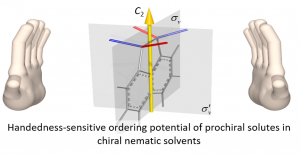Anant Kumar, Alexandros G. Vanakaras and Demetri J. Photinos, J. Phys. Chem. B, Article ASAP DOI: 10.1021/acs.jpcb.6b07404
ABSTRACT: We have developed a molecular theory for enantiotopic discrimination in prochiral solutes dissolved in chiral nematic solvents by means of NM R spectroscopy. The leading rank tensor contributions to the proposed potential of mean torque include symmetric as well as antisymmetric terms with respect to spatial inversion; these lead to consistent determination of all prochiral solute symmetries for which enantiotopes are distinguishable by NMR and also to excellent quantitative agreement when tested against the available experimental data for the rigid solutes acenaphthene and norbornene as well as for the moderately flexible ethanol molecule.
R spectroscopy. The leading rank tensor contributions to the proposed potential of mean torque include symmetric as well as antisymmetric terms with respect to spatial inversion; these lead to consistent determination of all prochiral solute symmetries for which enantiotopes are distinguishable by NMR and also to excellent quantitative agreement when tested against the available experimental data for the rigid solutes acenaphthene and norbornene as well as for the moderately flexible ethanol molecule.
Alexandros G. Vanakaras and Demetri J. Photinos
Soft Matter, 2016, DOI: 10.1039/C5SM02505B (Download)
We study theoretically the molecular origins of the fascinating, and still debated, nematic–nematic phase transition exhibited by symmetric, statistically achiral, mesogenic dimers. A simple molecular model that mimics the key features and symmetry (C2V) of this class of mesogens is presented. In the mean-field approximation, the model yields up to three positionally disordered phases, one isotropic and two nematic. The low temperature nematic phase (NX) has a local two-fold symmetry axis, which is also a direction of molecular polar ordering and is tightly twisted about a macroscopic phase axis. The onset of polar ordering generates spontaneous chiral symmetry breaking and the formation of chiral domains of opposite handedness, manifested primarily by the twisting of the polar director. Within these domains the statistical balance between the enantiomer conformations is slightly shifted and the principal axes of the ordering tensors of the molecular segments twist at constant tilt angles with the helical axis. Key experimental results on the NX phase of liquid crystalline dimers are discussed in the light of the theoretical predictions of the model, which are also contrasted with the predictions of the twist-bend nematic model.
 R spectroscopy. The leading rank tensor contributions to the proposed potential of mean torque include symmetric as well as antisymmetric terms with respect to spatial inversion; these lead to consistent determination of all prochiral solute symmetries for which enantiotopes are distinguishable by NMR and also to excellent quantitative agreement when tested against the available experimental data for the rigid solutes acenaphthene and norbornene as well as for the moderately flexible ethanol molecule.
R spectroscopy. The leading rank tensor contributions to the proposed potential of mean torque include symmetric as well as antisymmetric terms with respect to spatial inversion; these lead to consistent determination of all prochiral solute symmetries for which enantiotopes are distinguishable by NMR and also to excellent quantitative agreement when tested against the available experimental data for the rigid solutes acenaphthene and norbornene as well as for the moderately flexible ethanol molecule.